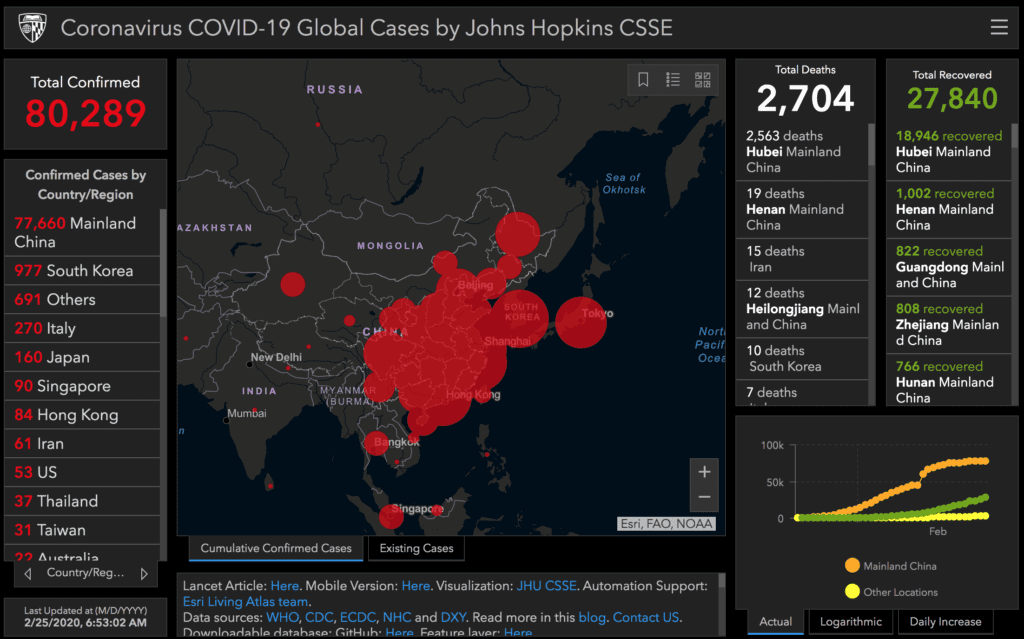A quick update to my series from last week. The coronavirus has not been contained to China, and there are now nearly 1000 cases in South Korea, 270 in Italy, and 60 in Iran.
Health experts and writers (see for example Ian MacKay, Devi Sridhar, James Hamblin, Helen Branswell, Michael Osterholm) now think it will eventually spread globally, meaning that containment strategies of travel restrictions will become increasingly ineffective.

We are now entering a phase of having to reduce the impact and harm associated with the spread of the virus, including taking precautions at the individual level to prevent infection like washing hands frequently and avoiding touching your mouth, eyes, and face.
(This is not the time for panic or overreactions, but I do think it is appropriate for us to be prepared for cases to come to countries that have not yet experienced an outbreak yet. Most cases are mild, but some are not).
I took a big bottle of hand sanitizer to the office and wrote our buildings manager about what plans they have in place to protect the workplace.
We also have a lot to learn about the virus, who is particularly at risk, and how deadly it might be.
A friend of mine asked me why I seem so worried about this disease given the low mortality thus far (less than 3000) given that other diseases like malaria continue to kill more than 400,000 people a year and infect hundreds of millions. The seasonal flu for example kills between about 300,000 and 650,000 people a year.
My answer is that the H1N1 swine flu outbreak ultimately had about 60 million infections but the mortality rate was less than .02% and somewhere between 151,700 and nearly 600,000 people died.
COVID mortality rate was 2% in early accounts compared to H1N1 swine flu in 2009-2010 where less than 0.02%. H1N1 killed somewhere between 151,700-575,400 people and caused 60 million cases. Maybe mortality rate for this one a lot lower than we think because of undiagnosed cases.
— Josh Busby (@busbyj2) February 23, 2020
The early mortality rate for COVID-19 has been around 2.3%. 2.3% of 60 million people would be nearly 1.4 million people. Now, the mortality rate outside of Wuhan has been lower, and we may see a much lower mortality rate as the disease spreads.
That said, there is a lot about this virus that we don’t know, and as it spreads to places like Iran and Afghanistan with poor health systems, the outcomes could be worse not better.
My main message for readers is to look for authoritative sources on how to protect yourselves from the WHO and CDC. I haven’t said much about government preparedness measures here, but the Trump administration has sent a request for $1.25 billion in emergency appropriations that critics say isn’t enough (with another $1.25 billion coming from budget flexibility). Time will tell.
Joshua Busby is a Professor in the LBJ School of Public Affairs at the University of Texas-Austin. From 2021-2023, he served as a Senior Advisor for Climate at the U.S. Department of Defense. His most recent book is States and Nature: The Effects of Climate Change on Security (Cambridge, 2023). He is also the author of Moral Movements and Foreign Policy (Cambridge, 2010) and the co-author, with Ethan Kapstein, of AIDS Drugs for All: Social Movements and Market Transformations (Cambridge, 2013). His main research interests include transnational advocacy and social movements, international security and climate change, global public health and HIV/ AIDS, energy and environmental policy, and U.S. foreign policy.


0 Comments